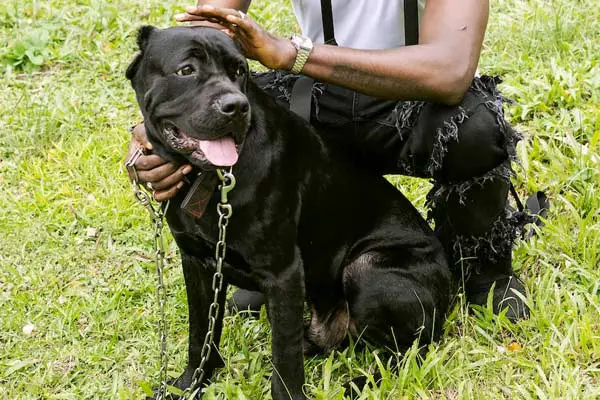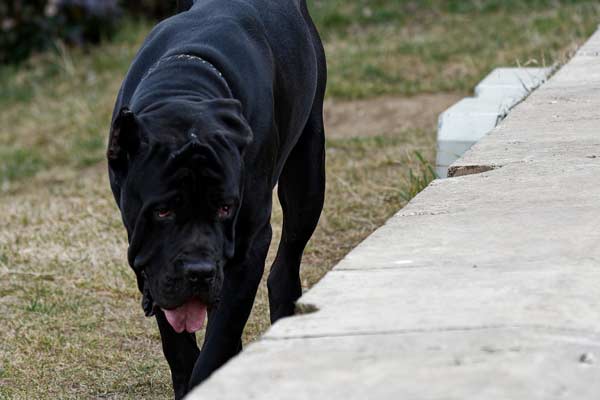Dog owners ponder the potential feats of their pets all the time. When you own a Cane Corso, it is impossible not to think about his strength and grace.
You wonder whether he will become dangerous and how you can temper aggression with socialization and training.
Fast on the heels of those thoughts, you probably ask yourself about the bite force and, “How fast can a Cane Corso run?”
How Fast Can a Cane Corso Run?
A Cane Corso can top out at just under 30 mph. However, this is the recorded speed of the fastest Cane Corso. Not every Corso can run that fast, so the average speed for the breed is probably closer to between 27 and 28.5 mph.
Is it possible that a speedy Cane Corso was never recorded? Of course, but even such a super dog probably only runs, at best, 32.5 mph.
The next thing to consider is that dogs, like any other animal, can only run at high speeds for a short distance. Their average speed over long distances is much lower, ranging between 10 and 17 mph.
How Long Can a Cane Corso Maintain Top Speeds?
A Greyhound can maintain its racing speed for over 250 yards. Remembering that most Cane Corsos will not have the conditioning of a race dog, your Corso will likely run at top speed for 150 yards.
How Do You Measure a Cane Corso’s Speed?
Measuring the speed of land animals was once informal, especially for dogs. Equipped with a stopwatch, officials kept records for decades. For animals that raced set distances, like humans, dogs, and horses, determining top speeds was easy over time.
For most non-racing dogs, it was different. You would jump into your car, see how fast you could drive, and not leave him behind.
With the explosion of luring, measuring top speeds has become more scientific for many breeds. However, some dogs will not chase a lure or go after it half-heartedly.
Nevertheless, the AKC adopted the Fast CAT (Coursing Ability Test) in 2016. The test is based on a lure and measures a dog’s speed over 100 yards. Officials then extrapolate the average of three runs into a speed they record in miles per hour. With such tests, the AKC can amass an official database for the running speeds of many dog breeds.
Conformational Traits of Cane Corsos that Affect Speed
Cane Corsos are no slouches when it comes to sprinting.
Among the fastest of the big-bodies dogs, Cane Corsos have a few traits that make them so agile. They also have features that prevent them from being even faster than they are.
Physical Qualities that Slow the Cane Corso Down
If you look at your Cane Corso, you will readily see at least a couple of reasons why she is not as fast as a Greyhound or Dalmatian.
- Massive, broad head with an almost square shape
- Large body mass
- Docked tail – although Cane Corsos are undoubtedly accustomed to their short tails, a longer tail might provide more counterbalance and ease of running.
- Neck not as long as sighthounds
- The rectangular body instead of square-shaped – more conducive to trotting than galloping
- Flat topline

Why Is a Cane Corso Significantly Faster Than the Average Dog?
- Balanced – all features are moderate compared to the Mastiff, with a longer, more refined neck, smaller head relative to the body, and smaller mass.
- Long powerful legs
- Sleek coat
- Skin folds on the neck and body minimal
- Arched, gripping toes
- Deep chest
- Rounded rump – allows the dog to get its power well underneath itself
How Fast Can a Cane Corso Run Compared to Other Common Animals?
- Fastest fish – 68 mph for the sailfish
- Fastest flying bird – 69 mph for common swift
- Fastest bird – 186 mph for Peregrine falcon during swooping
- Fastest flier – 99.5 mph for Brazilian free-tailed bat
- Cheetah – 58.4 to 65 mph; some sources say over 70 mph
- Pronghorn antelope – 61 mph
- Quarter horse -55 mph
- Lion – 50 mph
- Tiger – 30 to 40 mph
- Wolf – 31 to 37 mph
- Grizzly bear – 35 mph
- Hippo – 30 mph
- Bull – 30 mph
- Fastest human (Usain Bolt) – 28 mph
- Elephant – 25 mph
- Average human – 12 mph top speed
- Tortoise – 1.2 mph
As you can readily see, Cane Corsos runs at a top speed between a charging bull and an elephant.
How Fast Does the Average Dog Run?
The average domesticated dog can run about 15 to 20 miles per hour without training or conditioning. Most dogs are built for running with relatively long legs, grippy toes and nails, a flexible back, and deep chests.
Although you might not associate a deep chest with speed, it indicates a relatively large heart. Effective circulation is vital for any rapid movements.
Even though most canids are built to run, dog breeds are highly variable. Generations of selection have created dogs on two opposite ends of the speed spectrum.
What Determines Dog Running Speed?
Stride length and turnover are the main components of land speed for mammals. Among the most balanced animals, Greyhounds rival the speed of even racehorses, who contend with longer legs that slow down their stride turnover.
Cane Corsos, also balanced, are faster than you would expect. You will see that most dogs are built to run.
Slowest Dog Breeds
Some dogs have such an altered form that they can barely keep up with the average person, who runs 6.5 to 8.0 miles per hour.
The Basset Hound only sprints up to five miles per hour. Other slow breeds illustrate how conformation can detract from athleticism and fleetness of foot.
- Pug – 3 mph; severely brachycephalic, shallow chest, diminished lung capacity; there are exceptions; those without exaggerated features can reach over 17 mph.
- Shih Tzu – 6 mph; brachycephalic, shortened legs, elongated back
- Chihuahua – 8.8 mph; tiny size; larger ones run faster up to 21 mph
- Lhasa Apso – 12.8 mph
- Toy Poodle – 10 mph; small size
Fastest Dog Breeds
Fast dogs can outsprint a Thoroughbred over the first quarter of a mile. The fastest dogs have a set type:
- Lean frame
- Deep chest
- They have longer legs than most breeds relative to their bodies
- Narrow hips
- Arched loins
- Long lines, especially the neck, shoulders, and flanks
- Rounded springy lower back
- Elongated paws
- Narrow and elongated head
- Rat tail
Speediest dogs are the medium-large varieties of sighthounds, although there are a few exceptions in the sporting, terrier, and nonsporting groups.
- Greyhound – 40 to 45 mph, average just over 42 mph top speed
- Saluki – 42 mph; Middle East sighthound used to hunt gazelles
- Afghan Hound – 40 mph; long-haired sighthound of Afghanistan, Pakistan, and India used to course antelope and other game across the mountains
- Vizla – 40 mph; Hungarian sporting dog
- Ibizan Hound – 40 mph; medium-sized sighthound that coursed rabbits in Spain and France
- Borzoi – 37 to 40 mph; Russian sighthound
- Jack Russell Terrier – 30 to 38 mph
- Dalmatian – 37 mph; nonsporting dog once used to accompany horses and carriages.
- Whippet – 35 mph
- Weimaraner – 35 mph
- Pharoah Hound – 35 mph; medium-sized ancient sighthound of Egypt
- Doberman – 32 mph
- German Shepherd – 30 to 32 mph
- Great Dane – 30 mph
- Border Collie – 30 mph
Many working and herding dogs run around 30 mph. A Cane Corso’s top speed is about 29.8 miles per hour, according to AKC fast CAT data collected by Canecorsopet.com.
Dogs that defy the laws of gravity are the remarkably speedy Jack Russell with its short, sturdy build and the short-legged Corgi that can run 27 mph and has impressive stamina.
Cane Corsos are among the fastest Mastiffs, going against the disadvantages of their massive bodies and square-shaped heads.
In heavier breeds, you will often see that females hold some of the fastest times. Of the top speediest Cane Corsos, three of the five fastest dogs are females.
The fastest GSD recorded is a female. It shows that lightness is frequently an advantage over power when it comes to speed.

